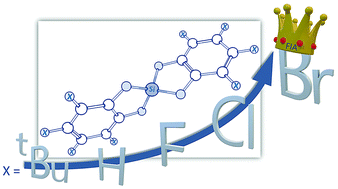Bis(catecholato)silanes: assessing, rationalizing and increasing silicon's Lewis superacidity†
Abstract
Although bis(catecholato)silanes have been known for several decades, their substantial Lewis acidity is not yet well described in the literature. Herewith, the synthesis and characterization of multiple substituted bis(catecholato)silanes and their triethylphosphine oxide, fluoride and chloride ion adducts are reported. The Lewis acidity of bis(catecholato)silanes is assessed by effective (Gutmann–Beckett, catalytic efficiency), global (theoretical and relative experimental fluoride (FIA) and chloride (CIA) ion affinities) and intrinsic (electrophilicity index) scaling methods. This comprehensive set of experimental and theoretical results reveals their general Lewis acidic nature and provides a consistent Lewis acidity trend for bis(catecholato)silanes for the first time. All experimental findings are supported by high-level DLPNO-CCSD(T) based thermochemical data and the Lewis acidity is rationalized by complementary chemical bonding analysis tools. Against the common belief that inductive electron withdrawal is the most important criterion for strong Lewis acidity, the present work highlights the decisive role of π-back bonding effects in aromatic ring systems to enhance electron deficiency. Thus, bis(perbromocatecholato)silane is identified and synthesized as the new record holder for silicon Lewis superacids.



 Please wait while we load your content...
Please wait while we load your content...